Advice for the Home Gardener from the Help Desk of the
UC Master Gardener Program of Contra Costa County
Help Desk Client: I think I have insects destroying my lawn. Would you please tell me what they are and what I can do to eliminate them?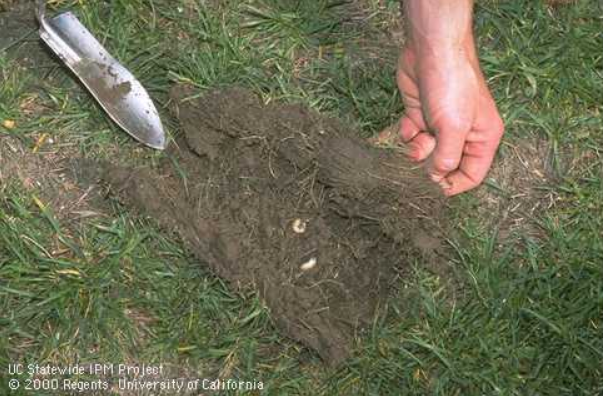
reveal 2 masked chafer larvae on soil.
The drench test will not identify one common lawn grub that feeds on the roots of turf grasses—the masked chafer or white grub. For guidance on identifying and managing that pest, you will want to consult this UC website: http://ipm.ucanr.edu/TOOLS/TURF/PESTS/inchaf.html
I hope that this information is useful. I apologize that we didn't have time to deal with some of your other garden questions. As we discussed, a good way to communicate with us about those problems will be to send us an email or come visit us at our office (below).
Help Desk of the UC Master Gardener Program of Contra Costa County (tkl)
Note: UC Master Gardeners Program of Contra Costa's Help Desk is available almost year-round to answer your gardening questions. Except for a few holidays (e.g., last 2 weeks December), we're open every week, Monday through Thursday for walk-ins from 9:00 am to Noon at 2380 Bisso Lane, Concord, CA 94520. We can also be reached via telephone: (925) 608-6683, email: ccmg@ucanr.edu, or on the web at http://ccmg.ucanr.edu/Ask_Us/. MGCC Blogs can be found at http://ccmg.ucanr.edu/HortCoCo/ You can also subscribe to the Blog.
Advice from the Help Desk of the
UC Master Gardeners Program of Contra Costa
Client: This weed is growing in my lawn. Could you please tell me what it is and how do I eradicate and/or prevent it?
MGCC Help Desk: Thank you for bringing the weed sample from your lawn for identification and recommendations on its elimination and control.
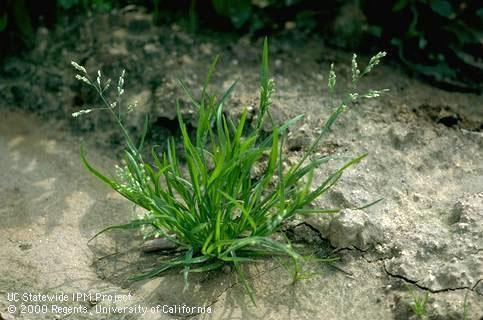
Annual bluegrass loves damp, shady areas. You can reduce favorable conditions for this weed by watering deeply and infrequently. The weed's shallow roots will not be able to reach down to where the moisture is. Annual Bluegrass will also invade lawns where the soil has become compacted. You can reduce lawn compaction by aerating during non-sprouting periods. This will allow water to settle deeper in the soil away from the shallow-rooted weeds.

For more information on this weed and its control, please see the UC Davis publication, How to Manage Pests in Gardens and Landscapes - Annual Bluegrass at http://www.ipm.ucdavis.edu/PMG/PESTNOTES/pn7464.html.
Please let us know if you have any additional questions
Help Desk of the UC Master Gardener Program of Contra Costa County (VLT)
Note: The UC Master Gardeners Program of Contra Costa's Help Desk is available year-round to answer your gardening questions. Except for a few holidays, we're open every week, Monday through Thursday for walk-ins from 9:00 am to Noon at 75 Santa Barbara Road, 2d Floor, Pleasant Hill, CA 94523. We can also be reached via telephone: (925) 646-6586, email: ccmg@ucanr.edu, or on the web at http://ccmg.ucanr.edu/Ask_Us/ MGCC Blogs can be found at http://ccmg.ucanr.edu/HortCoCo/ You can also subscribe to the Blog (http://ucanr.edu/blogs/CCMGBlog/).
Help for the Home Gardener from the CCMG Help Desk
Client has a problem with "brown spots" in the lawn:

in the lawn
The lawn in question is in Orinda and is 1000 sq ft. The lawn has brown patches which pull up without the roots attached. After contacting a lawn care company, the client was sent lawn care information assuming that the problem was white grubs. The client would like help sorting out the problem.
CCMG Help Desk's Response:
We took a quick look at the materials that you received from the lawn care/pest control company. They are good resources, but don't really answer your primary question as to the source of the problems you are experiencing. We concur that you need to do more investigation to confirm a diagnosis rather than just assuming that the cause is white grubs.
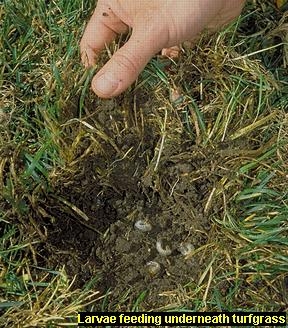
and larvae
Here is a link to a UC website that discusses the management of Masked Chafer Beetles and White Larval Grubs: http://www.ipm.ucdavis.edu/TOOLS/TURF/PESTS/inchaf.html. As you'll see when you visit the website, UC recommends that you dig around the roots of the turf in a damaged area in late fall through spring to look for the grubs. The website has good photos of what you are looking for. If you do locate the grubs, one of UC's recommendations for managing the problem is to apply beneficial nematodes.
This UC website describes the life cycle of the masked chafer beetle/white grubs: http://www.ipm.ucdavis.edu/TOOLS/TURF/PESTS/inchaflife.html As you'll see on the site, according to UC, the adults emerge from the ground and lay eggs in late spring and early summer. With this timing, the white grub larvae would be emerging during the summer months. UC recommends that for white grubs, nematodes should be applied in the late summer or early fall when more mature larvae are present and active. A second application about 2 weeks after the first will enhance control.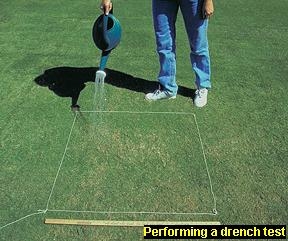
http://www.ipm.ucdavis.edu/PMG/PESTNOTES/pn7476.html. In particular, take a look at Table 2 which tells you whether you should use a drench test or dig in the area looking for signs of the insects. If you click on the blue highlighted names of the insects, you'll link to sites which have photos of what you are looking for.
If you decide to do a drench test, here's UC's website telling you how to do the test: http://www.ipm.ucdavis.edu/TOOLS/TURF/PESTS/indrench.hrml. We did some quick research and learned that the amount of dish soap that you use for the drench test should not harm the turf.
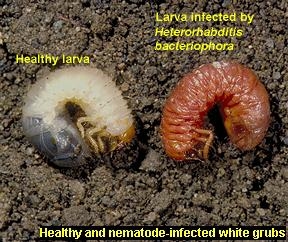
left: healthy larva
right: nematode infected
Finally, even with this information in hand, if you believe conducting these types of diagnoses isn't your forte, you could use this information to hire a consultant and/or pest control/lawn care company. CCMG can't make recommendations, but there are numerous sources in the telephone book and/or on the web. UC also provides some guidance in this area as well in the Pest Note “Hiring a Pest Control Company” (http://www.ipm.ucdavis.edu/PMG/PESTNOTES/pn74125.html)
CCMG Help Desk
Editor's Note: The Contra Costa Master Gardener Help Desk is available year-round to answer your gardening questions. Except for a few holidays, we're open every week, Monday through Thursday from 9:00 am to Noon at 75 Santa Barbara Road, 2d Floor, Pleasant Hill, CA 94523.
We can also be reached via telephone: (925) 646-6586, email: ccmg@ucanr.edu, and we are on the web at http://ccmg.ucanr.edu/

